Introduction
As mechanical engineers, we deal with motion control of rotating components on most machine design projects. Part of controlling motion means understanding what kinds of bearings and bushings to specify in our designs. In this article, we’ll cover bearing/bushing design considerations as well as a brief overview of common bearings and bushings with a focus on construction and practical applications.
Requirements and Considerations
Before diving into the selection process, it can be helpful to think through the requirements for the bearing or bushing in your application. Here's a short list of items to consider at this stage:
-
Purpose: Determine the specific function the bearing or bushing needs to fulfill in your design. Is it meant to support a rotating shaft, reduce friction in a linear motion, or handle radial loads? In rotating equipment, what RPM range do you need to support?
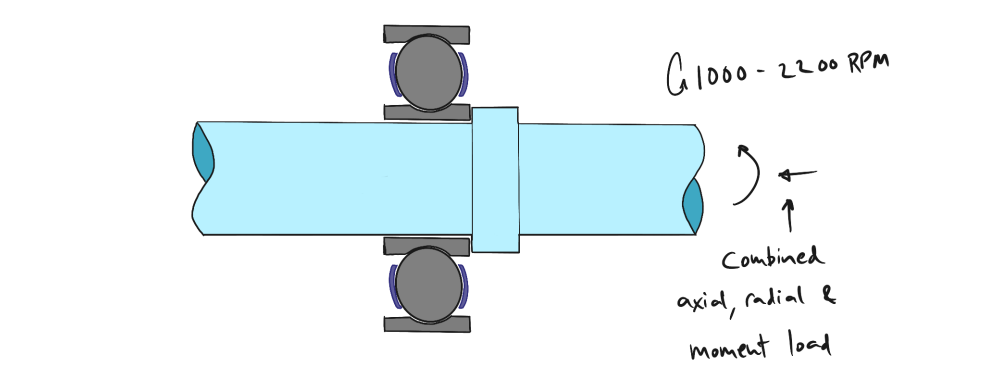
-
Loading conditions: One of the first steps in sizing bearings is to assess the expected loading conditions. Are there radial, axial, or moment loads? Or is it a combination? Is there a static load driving the design? Are there dynamic loads leading to fatigue considerations? Take your time at this step! A deep understanding of loading conditions can help you select the specific type of bearing needed for your application. (Ex: tapered roller bearings vs ball bearings)
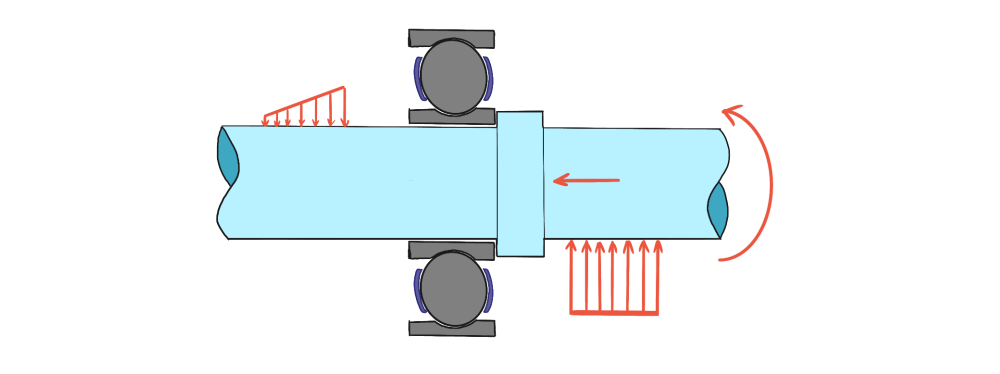
-
Safety factor: Determine the target safety factor for your application. A safety factor provides a margin of safety by multiplying the expected loads with a factor to ensure the component operates within a safe range. Bearings are part of dynamic systems that can sometimes have forces and moments that are difficult to estimate. Be conservative if possible!
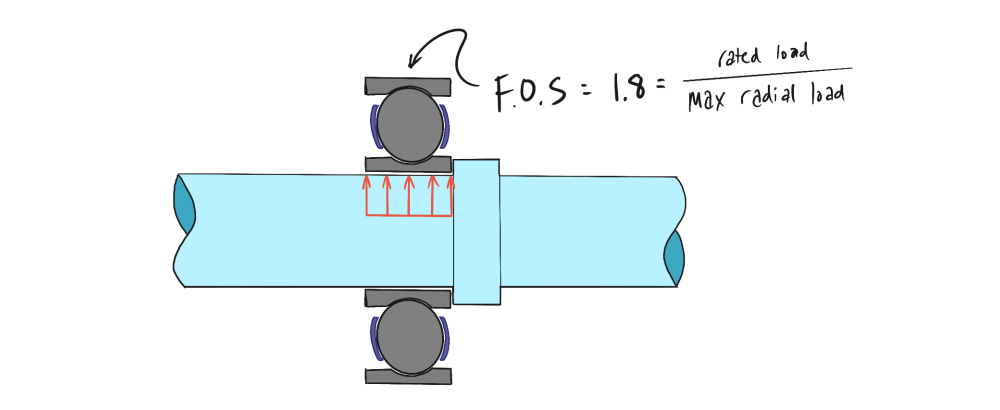
-
Design drivers: Outside of loading at the bearing, identify the main driving factors behind your design. Do you prioritize static strength, stiffness, fatigue resistance, or other performance characteristics? Is packaging a concern?
-
Material considerations: Think through material performance and interactions both for the bearing or bushing and the mating surfaces. Factors such as fatigue strength, corrosion resistance, galvanic interactions, temperature resistance, thermal expansion, and compatibility with other materials should be taken into account.
-
Assembly and serviceability: Evaluate how the bearing or bushing will be assembled and if it will require disassembly or servicing during its lifespan. Accessibility and ease of maintenance may end up being the most important driver of your component selection.
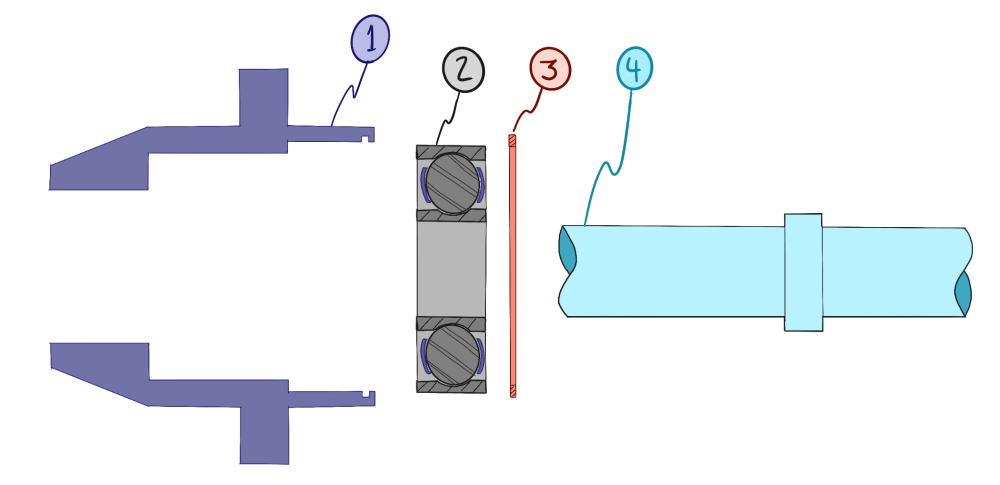
-
Lifespan and cost: Determine the desired lifespan of the bearing or bushing and consider the associated costs. Balancing longevity with budgetary constraints is crucial for achieving cost-effective designs.
You should have thought through the above concerns before you start digging into catalogs and detailed bearing specs.
Bearings vs Bushings
Before we get into the architecture and application of common bearings and bushings, it’s helpful to understand the key differences between the two:
-
Design and construction: Bearings are typically composed of two or more rings (or races) with rolling elements (such as balls or rollers) that roll between them. The rolling elements separate the races and minimize friction, allowing for smooth and efficient rotational motion. Bushings, on the other hand, are typically a single cylindrical sleeve that fits around a shaft or within a housing. They provide a low-friction interface between the shaft and the housing, allowing for smooth sliding or rotational motion.
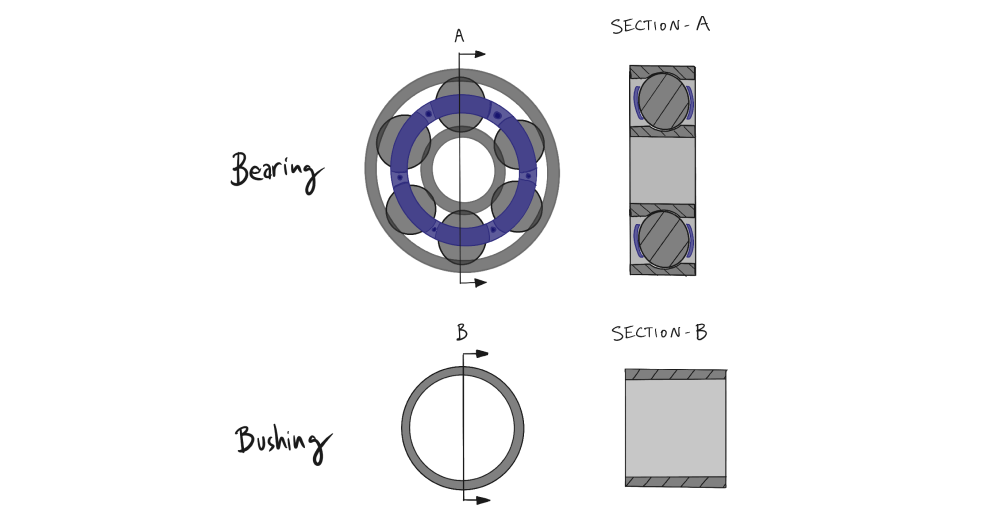
-
Load-carrying capacity: Bushings are great for low rotational velocity and high load applications. Bearings are better suited to high rotational velocity applications (because of rolling contact), but they typically have lower load carrying capacity when compared to a bushing of comparable size.
-
Lubrication: Bearings often require lubrication to minimize friction and prevent wear between the rolling elements and the races. Lubricants (grease or oil) are used to reduce friction, dissipate heat, and extend the lifetime of the bearing. Bushings, depending on their material and application, may or may not require lubrication. Some bushings are self-lubricating and contain solid lubricants within their material (i.e. oil impregnated bronze bushings), reducing the need for external lubrication. In other cases, lubrication may still be necessary to prevent excessive wear.
-
Cost: The simplicity of bushings mean they are typically 5 - 20X cheaper than bearings at comparable size ranges.
Types of Bearings
Once you have a clear understanding of the requirements, you can determine which bearing is best suited to your application. Here’s a quick overview of the most common bearing types along with some notes on their practical application.
-
Ball Bearings: Ball bearings are the most widely used type of bearing, known for their versatility and high load-carrying capacity. They consist of hardened steel balls that roll between two races, reducing friction and facilitating smooth rotation.
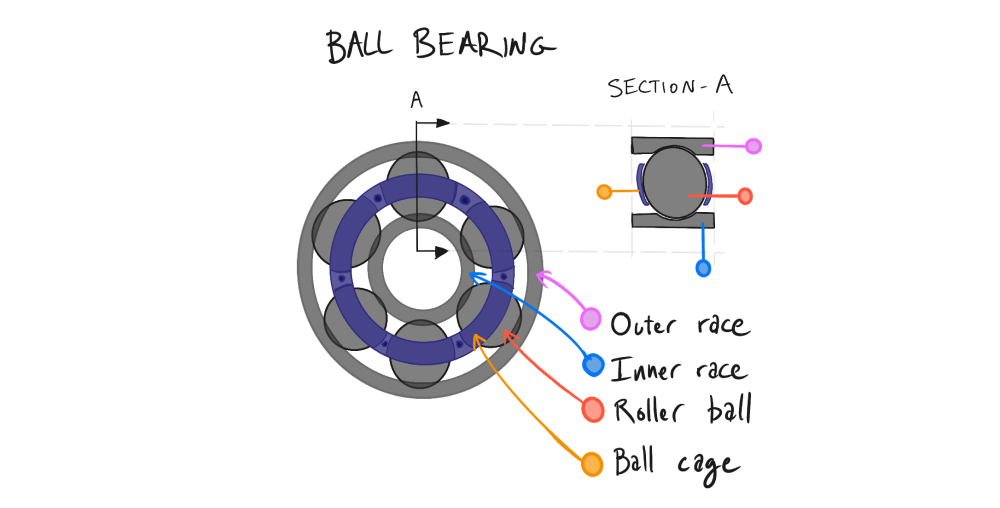
- Practical Application: Ball bearings are completely ubiquitous. You can find them in medium to large electric motors, wheels and hubs, conveyor systems, mountain bikes, and household appliances due to their low friction, high precision, and durability.
-
Roller Bearings: Roller bearings are designed to support heavy radial loads. From a first principles perspective they do this by reducing the point contact hertzian stress seen in ball bearings. This is accomplished by using cylindrical or tapered rollers instead of balls, distributing the load over a larger surface area (line load vs point load).
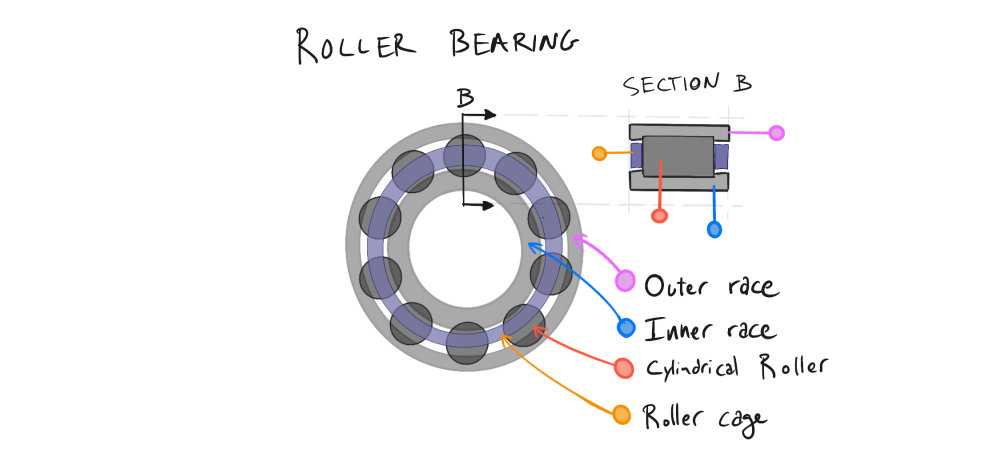
- Practical Application: Roller bearings are commonly used in construction equipment, heavy machinery, gearboxes, and railway applications, where they can handle substantial loads in a space efficient package.
-
Needle Bearings: Needle bearings, also known as needle roller bearings, are compact and have an extremely high load-carrying capacity. They utilize thin, cylindrical rollers with a length-to-diameter ratio that exceeds conventional roller bearings. Needle bearings are suitable for applications with limited space and where high radial rigidity is required.
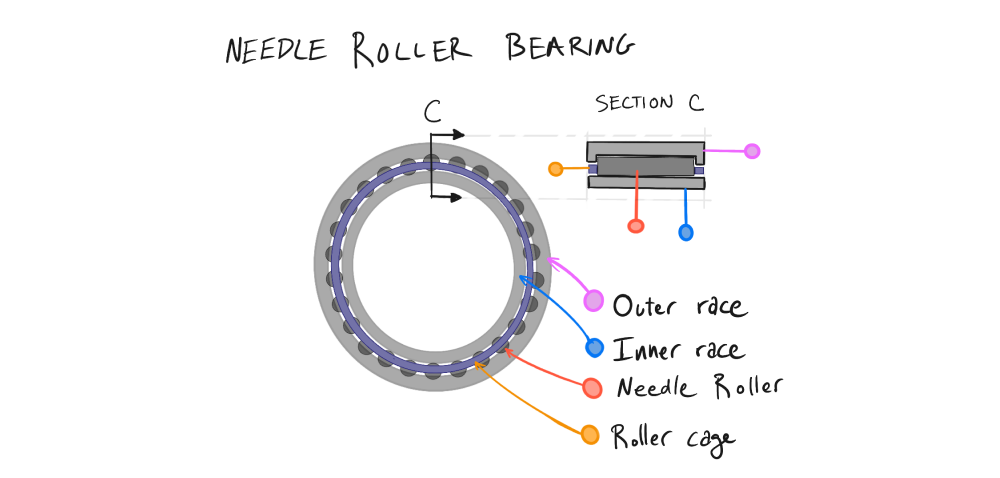
- Practical Application: Needle bearings are commonly used in automotive transmissions, motorcycles, industrial machinery, and aerospace applications, where space-saving design and high load capacity are essential.
-
Thrust Bearings: Thrust bearings are specifically designed to handle axial loads instead of radial loads. Thrust bearings resist axial loads in a single direction only, and are often used in pairs to constrain both directions of axial motion. They come in various configurations, including ball thrust bearings, roller thrust bearings, and tapered roller thrust bearings.
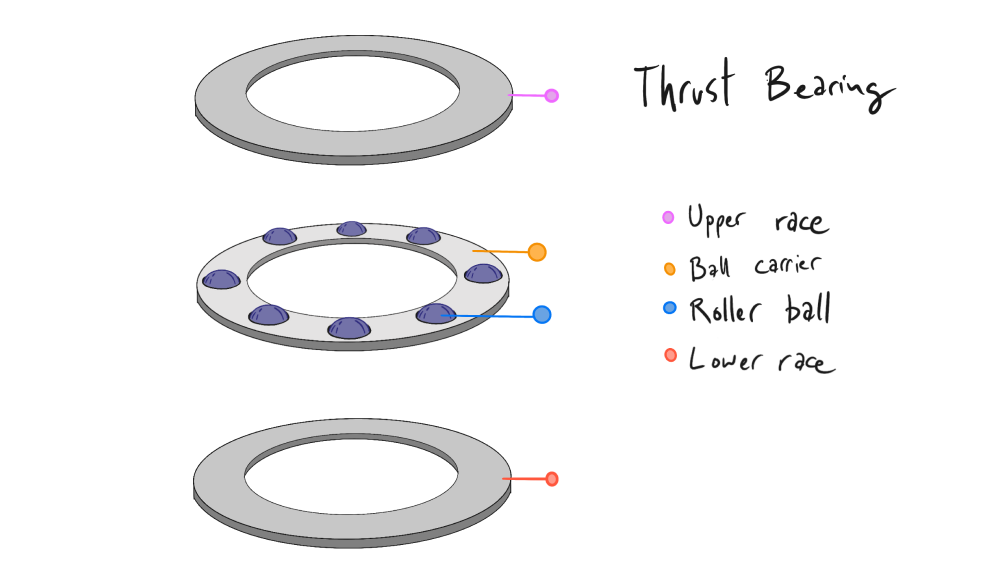
- Practical Application: Thrust bearings find applications in automotive drive-trains, steering systems, and machine tool spindles. Rotating systems that have dynamic axial loads (like manual gearboxes) are great for thrust bearings.
-
Spherical Bearings: Spherical bearings can accommodate misalignment and angular movement. They consist of an inner ring with a convex spherical surface and an outer ring with a corresponding concave surface. Note: From a construction and functional perspective, they are more similar to bushings than other bearings in this overview.
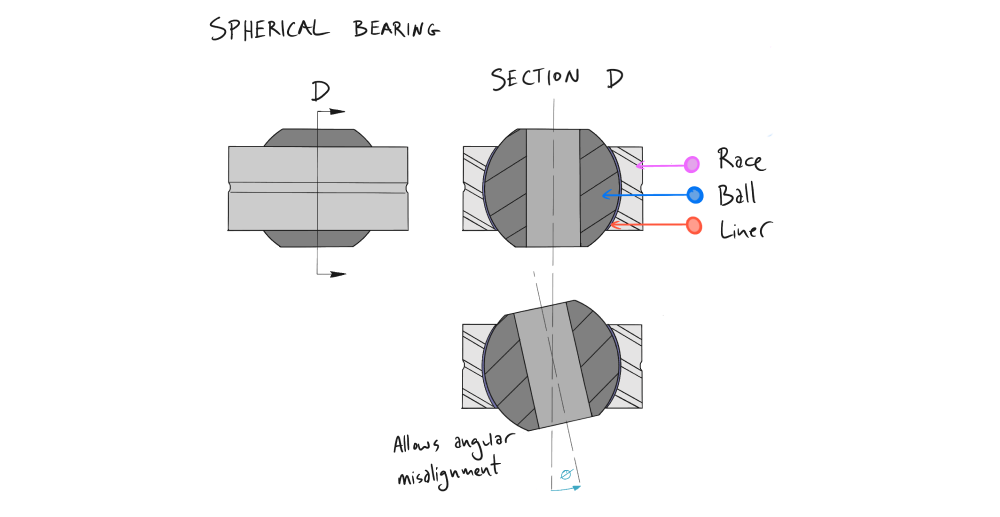
- Practical Application: Spherical bearings are commonly used in automotive suspensions, hydraulic cylinders, and agricultural equipment, where they compensate for misalignment, vibration, and impact loads. You can purchase them as stand alone spherical bearings, or packaged as threaded rod end bearings.
Types of Bushings
-
Sleeve Bushings: Sleeve bushings are cylindrical in shape and provide low-friction support for rotating shafts. They are typically made of materials such as bronze (often oil impregnated), brass, or polymers such as PTFE, Delrin (acetal) or PEEK.
- Practical Application: Sleeve bushings are widely used in small electric motors, household appliances, pumps, and fans, providing smooth and reliable shaft rotation at a very low cost.
-
Flanged Bushings: Flanged bushings are similar to sleeve bushings but have an extended flange at one end. The flange provides additional stability and prevents axial movement, functioning as a thrust bearing surface to handle higher axial loads.
- Practical Application: Flanged bushings are commonly used in automotive suspension systems, power tools, and plumbing fixtures, providing axial support and alignment for rotating shafts.
-
Thrust Washers: Thrust washers are flat washers designed to handle axial loads. They are an extremely low cost way to support lower RPM axial motion in a space efficient design.

Five Flute - Your source of truth for engineering collaboration
If you design, build, and test hardware products, Five Flute can help! Whether its part and assembly drawing review, remote and asynchronous 3D design review using our CAD integrations, or ECR/ECO management, Five Flute is your source of truth for engineering collaboration. Create an account if you want to build a source of truth for design review and day to day engineering collaboration.
